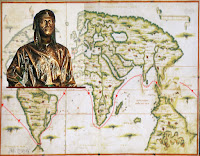3/04/2025
The Not-So-Humdrum Story of Magellan's "Genoese Pilot"
The Roteiro of "the Genoese Pilot" is one of ten surviving accounts of Magellan's voyage by a crew member, and it covers the fate of the Trinidad and crew after Antonio Pigafetta—who wrote the expedition's primary account—departed Tidore to return to Seville. Lord Stanley of Alderley translated this version and used it as the first account he presented in his 1874 collection on Magellan.
The Genoese Pilot's Account of Magellan's Voyage
 |
| From Abraham Ortelius's Americae Sive Novi Orbis, Nova Descripto, 1570. (Source.) |
Navigation and Voyage Which Fernando de Magalhaes Made from Seville to Maluco in the Year 1519. By a Genoese Pilot.
He sailed from Seville on the 10th day of August of the said year, and remained at the bar until the 21st day of September, and as soon as he got outside, he steered to the south-west to make the island of Tenerife, and they reached the said island on the day of St. Michael, which was the 29th of September.1 Thence he made his course to fetch the Cape Verde islands, and they passed between the islands and the Cape without sighting either the one or the other. Having got as far as this neighbourhood, he shaped his course so as to make for Brazil, and as soon as they sighted the other coast of Brazil, he steered to the south-east2 along the coast as far as Cabo-frio, which is in twenty-three degrees south latitude; and from this cape he steered to the west, a matter of thirty leagues, to make the Rio de Janeiro, which is in the same latitude as Cabo-frio, and they entered the said Rio on the day of St. Lucy, which was the 13th December, in which place they took in wood, and they remained there until the first octave of Christmas, which was the 26th of December of the same year.
2/27/2025
Updates: Magellan, Biographies and Long-Form Accounts
After some distraction,* I'm finally updating this blog's Resources pages again, starting with Biographies and Long-Form Accounts of Ferdinand Magellan and related history/characters. Added are several entries, old and new, and basic sources that include related documents and materials.
12/04/2024
Marryat and the Mighty HMS Minden, Hong Kong Hospital Ship
 |
| HMS Minden (center-left) during the bombardment of Algiers, 1816. (Source.) |
Frank Marryat’s first impressions of Hong Kong, of Britain’s brand-new colony, were far from positive. Marryat took issue with reports of crime, a swamp named Happy Valley, and the daily deaths of sailors as advertised by the flag flying at half mast aboard HMS Minden, which anchored in Hong Kong Harbor was serving as a hospital ship.
12/03/2024
Frank Marryat, First Impression of Early Hong Kong
When the British took possession of Hong Kong in 1840, their new colony consisted of just Hong Kong island, largely a baron rock except for a few fishing villages. It would be ten years (1856) before the British gained control of the adjacent Kowloon Peninsula and thus the north side of Hong Kong’s Victoria Harbor and fifty-seven years before they leased the badly needed water resources of the New Territories and Outer Islands.
12/01/2024
Frank Marryat Attempts to Sketch the World (1840–1850) from Hong Kong to California
 |
| Hong Kong and San Francisco (Library of Congress). |
7/22/2024
Columbus and the Ruysch World Map: When the Vikings Reached Asia?
 |
| Johannes Ruysch world map. |
If you plot Leif Erikson's voyage of discovery on Johannes Ruysch’s world map of 1508, the Viking explorer reaches not just Newfoundland but the easternmost point of the Asian continent, a land he labeled “Terra Nova” (New World).
Given the knowledge of the day—five years before Vasco Núñez de Balboa found the “South Sea”—Ruysch missed the existence of North America and the Pacific Ocean. In this way the map serves as a window into the worldview of Christopher Columbus, who believed to the end that Japan and China lay not far beyond Hispaniola.
5/19/2024
Ptolemy World Map: Greco-Roman World View
 |
| Ptolemy world map created by Lord Nicolas the German in 1482. |
It wasn’t Columbus or Magellan who proved the world was round. The flat Earth notion we hear about today was a medieval phenomenon. By 500 BCE the Greeks had established that the planet was a sphere, and in time estimated its size with surprising accuracy.
Magellan Reaches Guam: Chamorro Outriggers Take On Spanish Carracks
 |
| Reception of the Manila galleon by the Chamorro at Guam, c. 1590. |
March 6, 1521: Ferdinand Magellan's fleet reached Guam after a deadly three-month crossing of the Pacific Ocean. In explaining the encounter, biographers typically highlight the sensational story of larcenous natives that met the fleet and how the Spanish thereby chose the name Ladroni Islands ("Thieves' Islands") for Guam and Rota.[1] Stories like that sell books. But the two eye-witness reports of the experience tell a second story, of the Chamorros' amazing boating skills and boats, and the only accounts we have of course offer only the Europeans' perspective.



